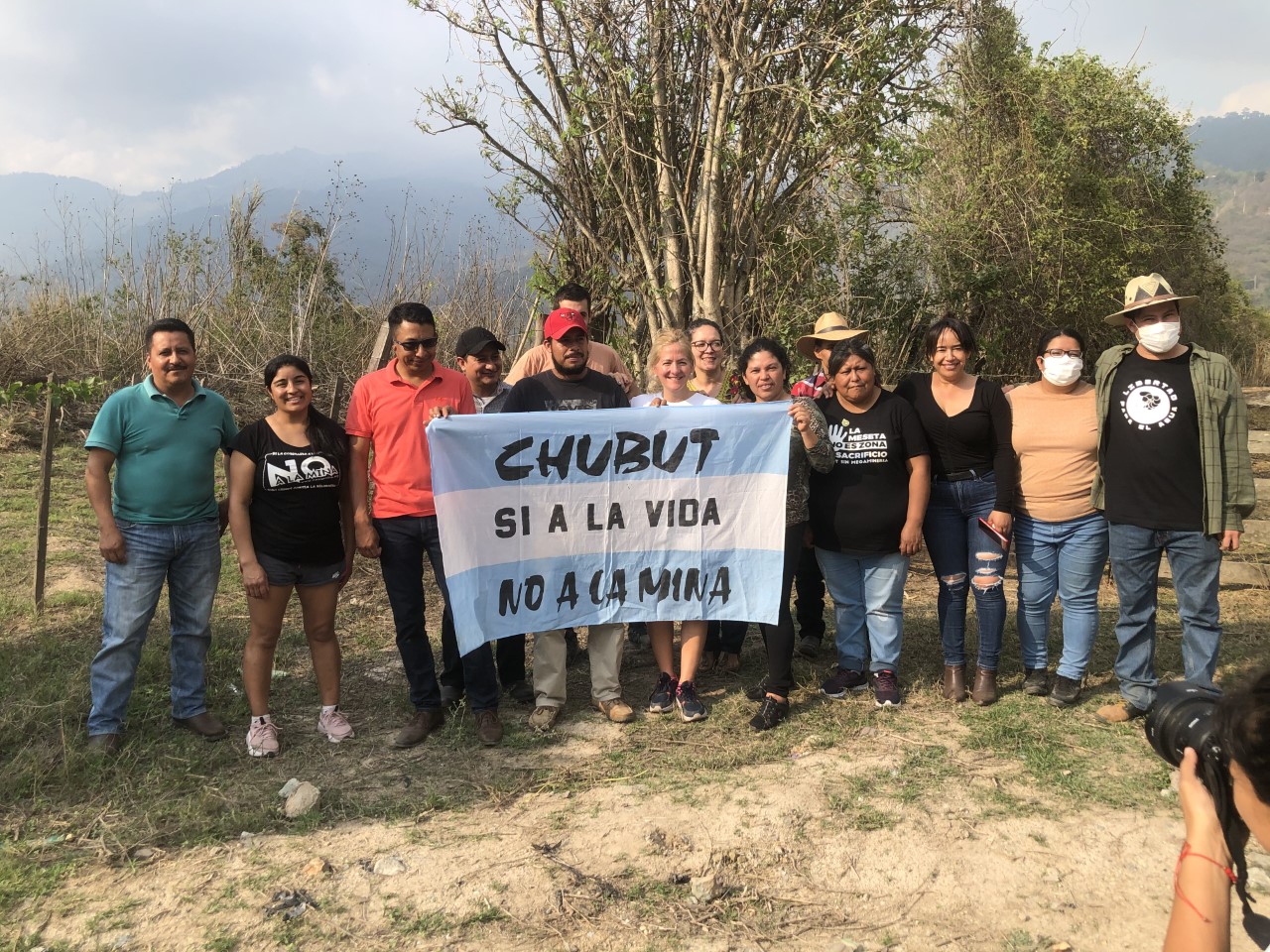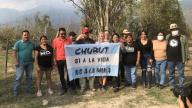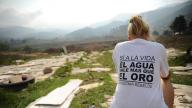For close to twenty years, communities affected by proposed mining development in the Patagonia region of southern Argentina have held a standing engagement on the 4th day of every month: to march in defence of life and reiterate their commitment to uphold the results of a 2003 referendum that said ‘NO’ to industrial mining.
In the years since the referendum, communities and Indigenous Mapuche Tehuelche peoples organized across Chubut have played a vital role in the region’s environmental movement, succeeding in passing provincial legislation in 2003 to ban open-pit mining and the use of cyanide throughout the province of Chubut. With the climate crisis worsening, the Union’s monthly marches have become a referent across Argentina to protect land from becoming ‘sacrifice zones’ in the race to mine for energy transition metals.
The ban on open-pit mining hasn’t stopped companies from coming, however. Canadian mining company Pan American Silver acquired the Navidad silver deposit in 2010 with the knowledge that existing environmental legislation would need to be overturned if the project were to become viable. At the same time as the company promotes itself as an industry leader in environmental stewardship, it has been accused of lobbying provincial regulators to gut key environmental legislation to turn its massive silver deposit into an operational mine. Yet affected communities are staying firm and organized in their opposition.
It is agains this backdrop that representatives of the Mapuche Tehuelche and the Union of Assemblies of Chubut are in Guatemala this week, exchanging experiences with communities affected by the company’s controversial Escobal mine at the first “Regional Summit of Peoples Affected by Pan American Silver.” Two petitions have been launched in solidarity, calling on Pan American Silver to respect the Indigenous rights to self-determination of the Mapuche Tehuelche in Argentina and the Xinka in Guatemala in the face of powerful mining interests.
Rhetoric versus reality
Founded in 1994 by Ross Beaty, a well-known conservationist in British Columbia, Pan American Silver has largely been ahead of industry trends in adopting environmentalist language to promote its operations as responsible and sustainable. The company is an outspoken proponent and promoter of the Mining Association of Canada’s Towards Sustainable Mining voluntary reporting standards (adopted by the Argentine Chamber of Mining Business) and was one of the few mining companies to report under the UN Compact voluntary standards for responsible business — describing ways they are lowering their emissions and recognizing climate change in their planning and investment.
Pan American Silver, whose CEO Michael Steinmann is a past president of the Silver Institute, is heavily focused on promoting silver as a key metal for the energy transition. The company organized a 2018 conference in Buenos Aires, Argentina, on silver’s role in combatting the climate crisis, and describes its use in a variety of purposes “from energy generation to protecting human health.” In its 2020 Sustainability Report, Pan American Silver emphasizes that it will “work with the Silver Institute to improve the general understanding of silver’s role in the transition to a low-carbon economy,” and often parrots the Institute’s logic for projecting increased demand:
“Silver should gain from the ‘best of both worlds’ narrative. In other words, silver will benefit both from its precious metals credentials, against the backdrop of low interest rates and concerns about inflation, and its industrial metal ones, given a synchronized post-pandemic recovery and policy-makers’ focus on silver-consuming green energy applications.” (World Silver Survey 2021, p. 8)
While the company paints silver as a key transition metal, the real need for new silver mining is another story. The Silver Institute indicates that since 2016, global silver market production has outpaced demand every year at an average rate of 48 million ounces per year — meaning on average, the world produces 48 million ounces of silver that it does not need — and despite the industry discourse around climate change, most of that is not going into energy transition technology. As of 2021, 42% of total silver consumed was for luxury goods (jewelry) and bullion (investment). Only 10% was used for photovoltaic technology — what goes into solar panels — while another 30% went to other industrial processes. Only 18% of the total silver supply is coming from recycling, a share which the industry itself claims could grow.
Given these scenarios, it is very possible to imagine a future with no new silver mining at all. Instead, the mining industry shifts from climate change denial to seeing it as a business opportunity, willing to further endanger the health of communities and the environment in the name of fighting the climate crisis. And as a recent mapping of the conflicts associated with mining for energy transition metals demonstrates, frontline communities are living the consequences of this rhetoric.
More mining at all costs? Projecting a massive toxic waste problem at Navidad
While the Navidad project in Argentina remains in its pre-economic feasibility stage, Pan American Silver has identified Navidad – along with the currently-suspended Escobal mine in Guatemala and La Colorada mine in Mexico – as catalysts for company growth. Clear community opposition to the project and a current legislative ban on open-pit mining has not dissuaded the company from promoting the project to shareholders as a massive silver-copper-lead deposit that, if brought into production, could become one of the largest mines in the world, with the lowest production costs across the company’s operations.
But the material and ecological footprint of Navidad is staggering. The projected 17-year mine plan includes working six active open pits, each with a diameter of between 0.5 and 1.5 kilometres. Once reaching full production, the on-site mill would process 15,000 tonnes of ore per day. The silver-copper and silver-lead concentrates would subsequently be shipped around the globe to be reprocessed and refined, ultimately producing approximately 5 million ounces of silver per year.
Over the mine’s lifetime, the pits would generate 418 million tonnes of waste and uneconomic ore — roughly equivalent to 13 years of yearly landfill waste generation in all of Canada. Ten million of those tonnes would be stored in a liquified tailings pond, with the vast remainder ending up in waste heaps alongside the pits, to be exposed to the elements and oxidize and leach into the surrounding environment for perpetuity. The operations, like all open-pit mining operations, would also require a significant amount of water, which is particularly concerning for the communities in the meseta (plateau) region of the province where the proposed mine is located — some of whom have been without access to water since 2020. As part of the company’s own reporting to the UN Compact, the region was characterized as high risk for drought exacerbated by climate change even before the mine is built, a recognition which echoes local communities’ concerns about how this mine would impact an already precarious watershed. The meseta is home for the Mapuche Tehuelche Indigenous peoples and local agricultural and tourism livelihoods depend on having reliable access to this critical life source.
Sharing experiences in the fight for self-determination
The Union of Community Assemblies of Chubut (UACCh), along with many Indigenous communities across the province, have marched every month for nearly 20 years and continue to do so because they know that their power to decide what happens on their lands is constantly under threat. Recently, they relaunched a popular initiative to present a bill which, if turned into law, could further strengthen protections for water and the environment from the devastating impacts of industrial mining. As part of the effort to strengthen cross-border organizing, the Mapuche Tehuelche peoples and the Assemblies sent representatives this week to participate in the Regional Summit of Peoples’ Affected by Pan American Silver.
There, they are meeting with the Peaceful Resistance of Santa Rosa, Jalapa and Jutiapa who, for over a decade, have organized to peacefully resist the Escobal mine which Pan American Silver took over when it acquired Tahoe Resources in 2019. An encampment blocking mine-related traffic and a subsequent Constitutional Court order have suspended operations at the Escobal mine since 2017. They’ll also meet with the Xinka Parliament, which is currently participating in a Constitutional Court-ordered consultation process around the Escobal mine, in an effort to exercise their Indigenous rights to self-determination.
At next week’s shareholder meeting, Pan American Silver will undoubtedly claim to be an industry leader in environmental protection and social responsibility. But although the company may choose to ignore opposition, communities affected by its projects across Latin America are meeting and strengthening a pan-American resistance to mining.


